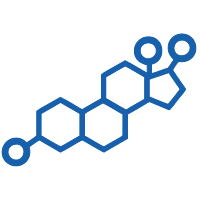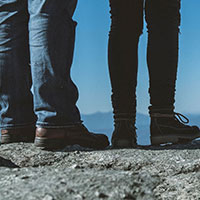The sun is a beautiful thing. It’s warm, it’s bright, and it makes us feel good. It draws us outside and begs us to enjoy all the things Tennessee has to offer. Summer is in full swing, and the sun is at its strongest.
Whether you’re hiking the Cumberland Trail, hitting the links in Sparta, boating at Center Hill Lake or fishing at Rock Island State Park, we want to make sure you’re prepared with the right information so you and your family can enjoy the season safely.

Skin and Sun Safety Facts
Your skin is your largest organ. For an average adult, skin covers about 22 square feet of surface area and accounts for about 15% of body weight. As well as protecting our bodies from the elements, our skin also helps synthesize sunlight into Vitamin D—an essential nutrient for good health. However, humans aren’t always careful to protect this vital part of the body, especially when it comes to summer sun.
The sun produces ultraviolet (UV) rays. These rays are forms of radiation and are harmful to the skin.
Sunburns are one type of skin damage caused by UV rays. In fact, sunburns are the most common reason for visiting the doctor during the summer months. Though we sometimes dismiss sunburns as merely uncomfortable, they are harmful beyond redness and pain. Sunburns cause the skin to age faster and are the leading cause of many skin cancers.
Sun exposure is the most preventable risk factor for all types of skin cancer. According to the Skin Cancer Foundation, 1 out of 5 Americans will develop some form of skin cancer in their lifetime. That’s a staggering number. Plus, it can take only 15 minutes to start feeling the effects of overexposure.
To ensure that you get outside this summer without worry, we’ve put together nine tips for sun safety.

9 Sun Safety Tips
- Stay in the shade. One way to limit UV exposure is by avoiding being outdoors in direct sunlight too long. Also, be aware that highly reflective surfaces like sand or water can increase the UV radiation that reaches you. And don’t be fooled by hazy days. The sun’s UV rays can still be dangerous.
- Avoid the sun at its peak. UV light is strongest between 10 am and 4 pm.
“If your shadow is shorter than you are, the sun’s rays are the strongest, and it’s important to protect yourself.”
~American Cancer Society.
- Wear a hat. Stay cool while looking stylish. For head protection, choose a wide-brimmed hat that shades your face, neck, and ears.
- Wear sunglasses. Complete your sun ensemble with sunglasses that have wraparound UV-blocking lenses. Don’t assume darker lenses offer better protection.
- Cover your skin with clothing. Clothing not only offers protection against the sun’s harmful rays but can also help prevent dehydration. Select light, loose-fitting long-sleeved shirts and long pants made of tightly woven fabric like cotton.
- Wear sunscreen with at least SPF 30. In addition to wearing protective clothing, you can protect your skin by applying a broad-spectrum sunscreen (filtering both UVA and UVB rays). Remember that sunscreen is only a filter. No sunscreen blocks UV rays completely. All sunscreens are different, so read the label to choose the most sun protection.
- Avoid tanning beds and heat lamps. If you think tanning beds are harmless, think again. Like the sun, tanning beds and some heat lamps emit UV rays. These devices can lead to skin cancer, premature aging of the skin, and other problems.
- Assess your risk. All skin types and colors are susceptible to sun damage. However, fair people with pale skin and people with light hair (blond, red, or light brown) should be more cautious. Also, if you take medications, ask your healthcare provider if they increase your sun sensitivity. If you have a history of skin cancer, avoid the sun.
- Check your skin. When skin cancer is detected early, it’s highly curable. Learn how to do a proper self-examination. Check for new spots or growths, including moles, freckles, and areas that are irritated or inflamed. See your doctor if you notice any changes on your skin or find an unusual lump or bump.
Summer Sun Safety for Kids
Because children tend to spend more time outside and can burn more quickly, they need special attention for sun protection.
Follow the above sun safety tips to help keep kids safe from sun exposure. It’s essential in sunny regions, like Tennessee and the South, where the sun is stronger.
Younger children may be fussy about wearing hats and sunglasses, but many quickly become accustomed to them. Also, be wary of toy sunglasses. Make sure they have a UV protection label.
Another point to remember is that UV rays can penetrate water. Kids are not safer from the sun when in the water. No sunscreen is completely waterproof. Remember to reapply sunscreen while playing in the water and after a swim.
Be sure to educate your children about sun exposure dangers. Children often are not aware of the risks. Also, as kids get older, some feel like their youth makes them invincible, and they ignore sun safety.
Your Babies and the Sun
Babies have delicate skin and need additional sun protection. Keep children younger than 6 months out of direct sunlight. When outside, use your stroller’s cover or an umbrella. Sunscreen is NOT recommended for babies under 6 months.
Dress your babies in lightweight clothing that covers their arms and legs. Be sure to include a wide-brimmed hat.
Riding in a car can expose infants to UV rays as well. Consider using removable mesh window shades or UV window tinting to keep direct sunlight from coming through the windows.
Enjoy the Summer Sun Safely
Summertime means many things for Tennesseans. It’s a time where we can enjoy our outdoor bounty. The summer sun is one of the most beautiful parts of our summers, but it can also be harmful to our skin. This is especially true for children and infants who need special protection.
From chasing one of Tennessee’s waterfalls, walking or hiking in the Upper Cumberland, or just splashing about at Cookeville’s Dogwood Park, be smart about how you spend time in the sun. Follow our summer sun safety tips and help yourself and your kids and babies stay protected.
Sources :
https://www.cancer.org/healthy/be-safe-in-sun.html
https://www.cancer.org/healthy/be-safe-in-sun/uv-protection.html
https://www.skincancer.org/risk-factors/sunburn/
https://www.skincancer.org/skin-cancer-information/skin-cancer-facts/
https://www.fda.gov/consumers/consumer-updates/tips-stay-safe-sun-sunscreen-sunglasses
https://www.fda.gov/consumers/consumer-updates/indoor-tanning-risks-ultraviolet-rays
https://www.ucsfbenioffchildrens.org/education/sun-safety-for-children-and-babies
Medically reviewed by Dr. Seth Means











